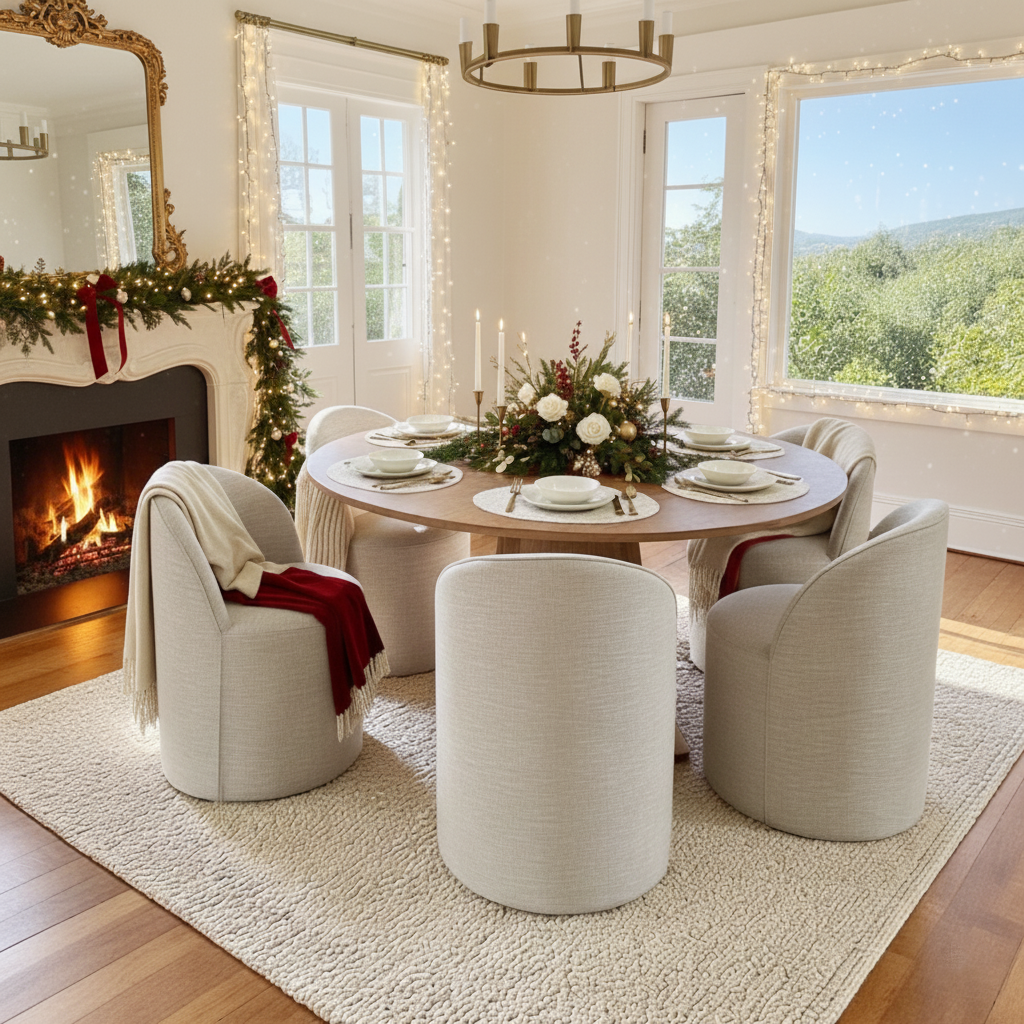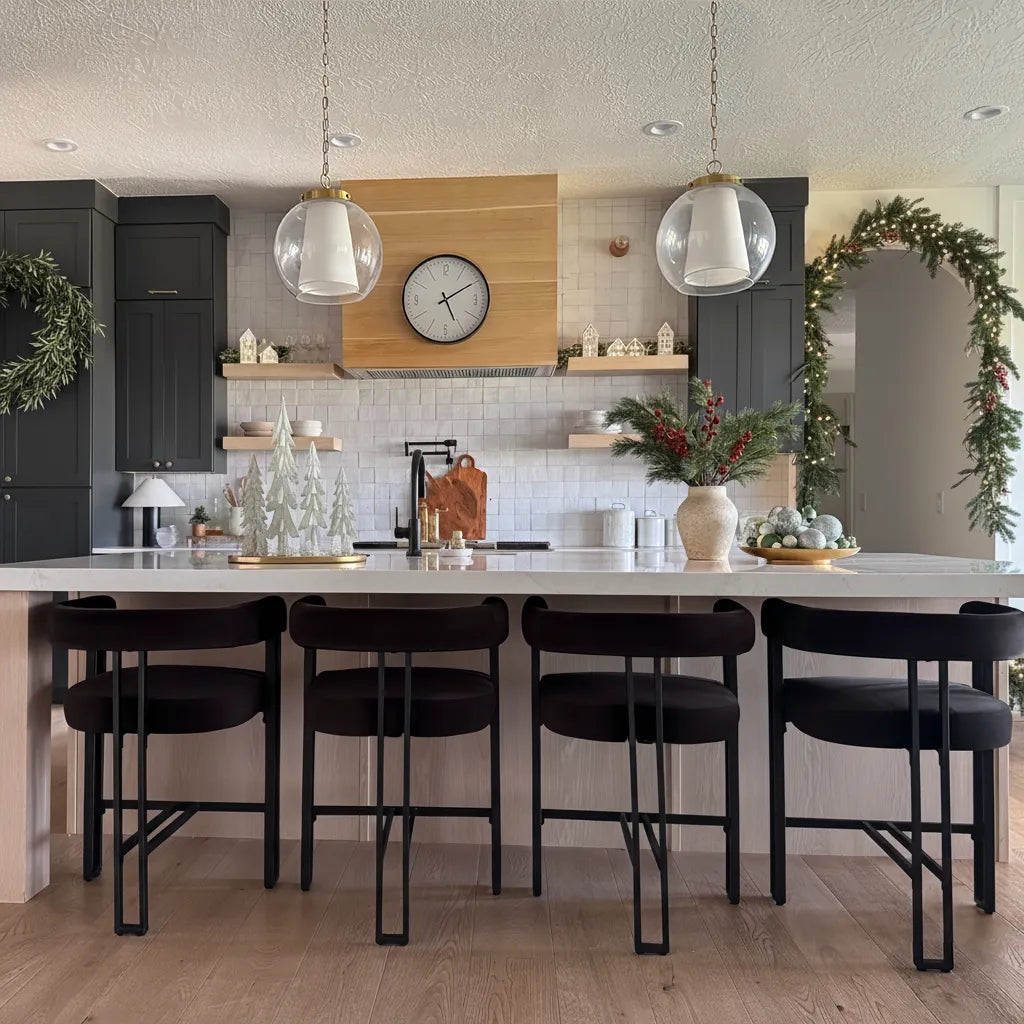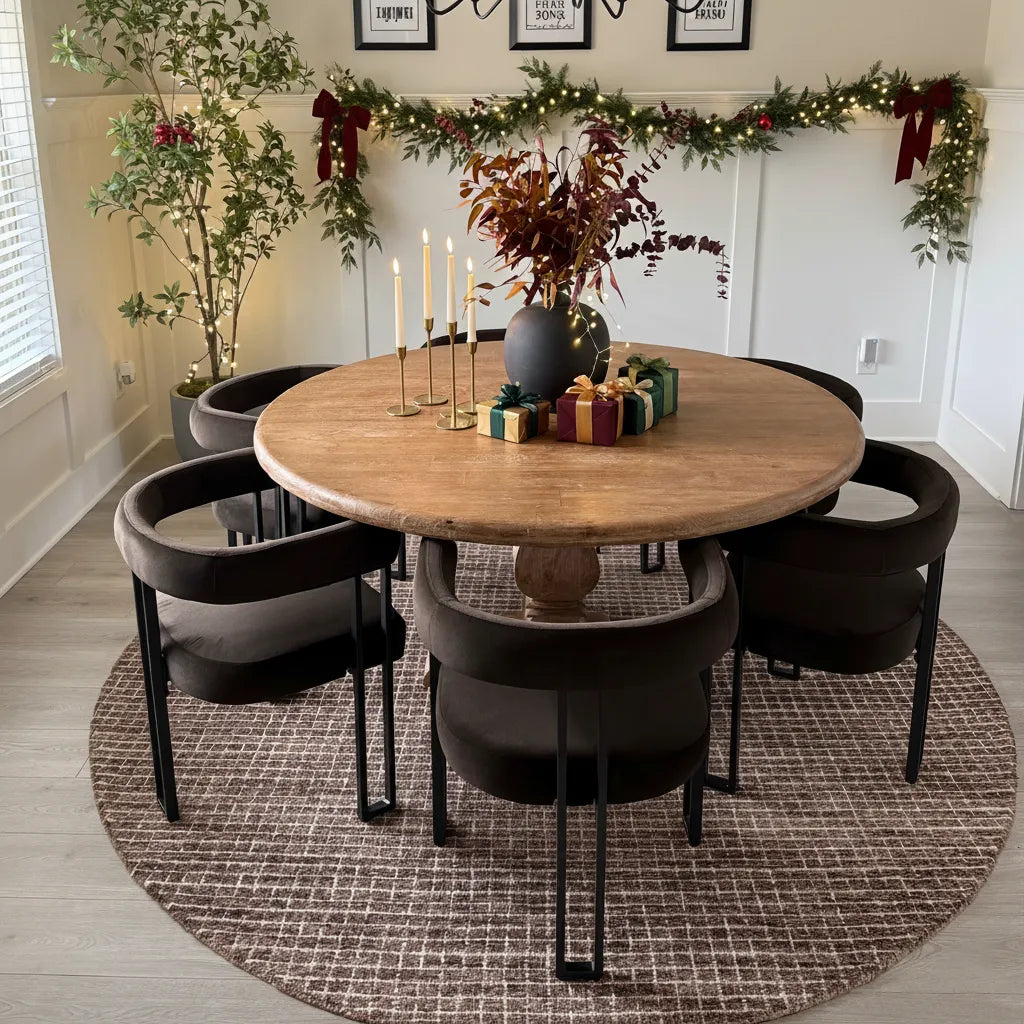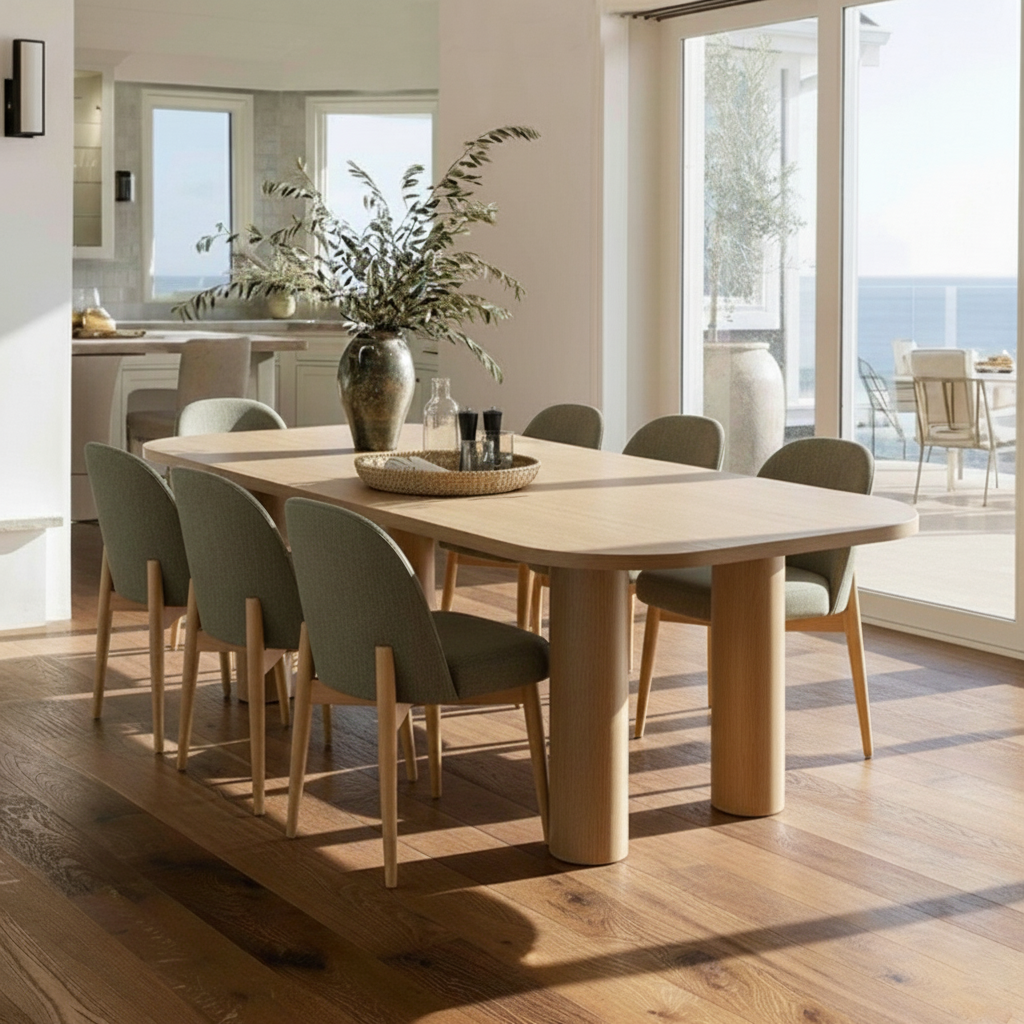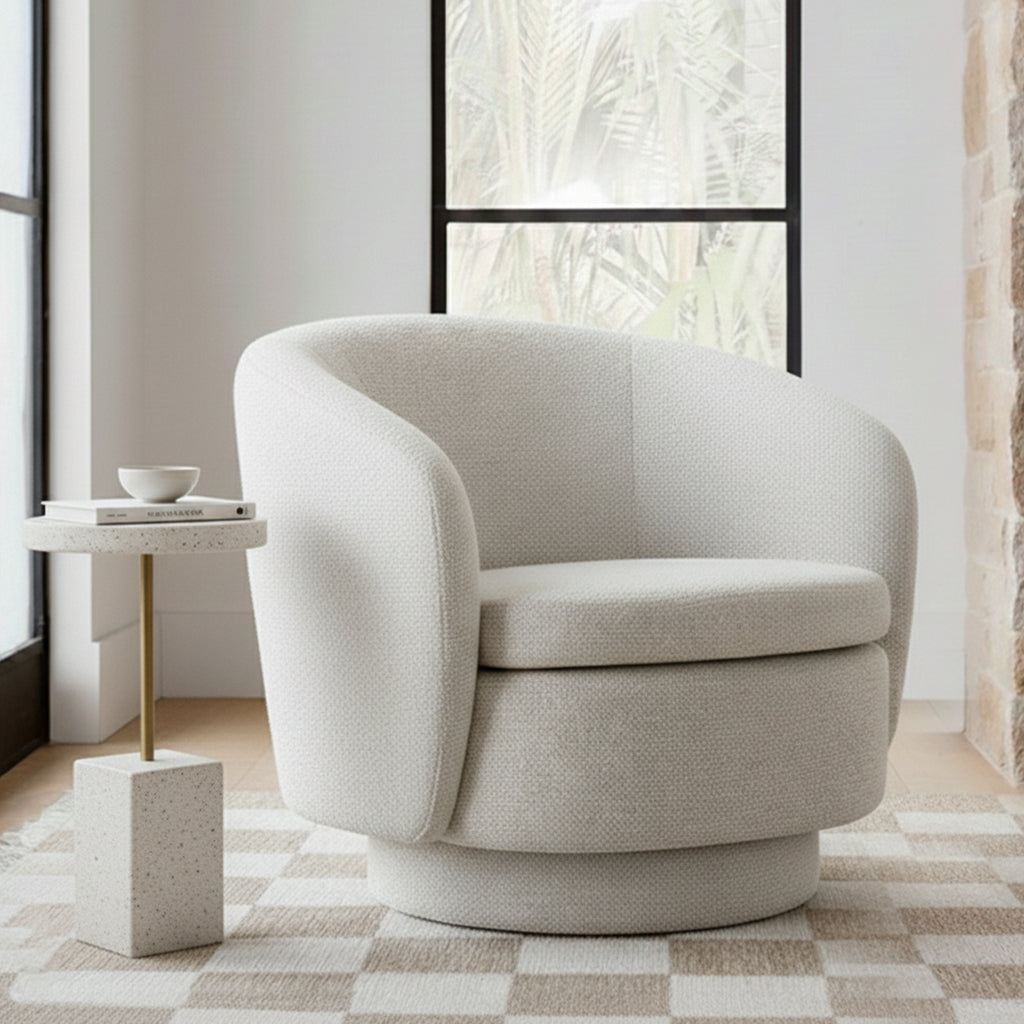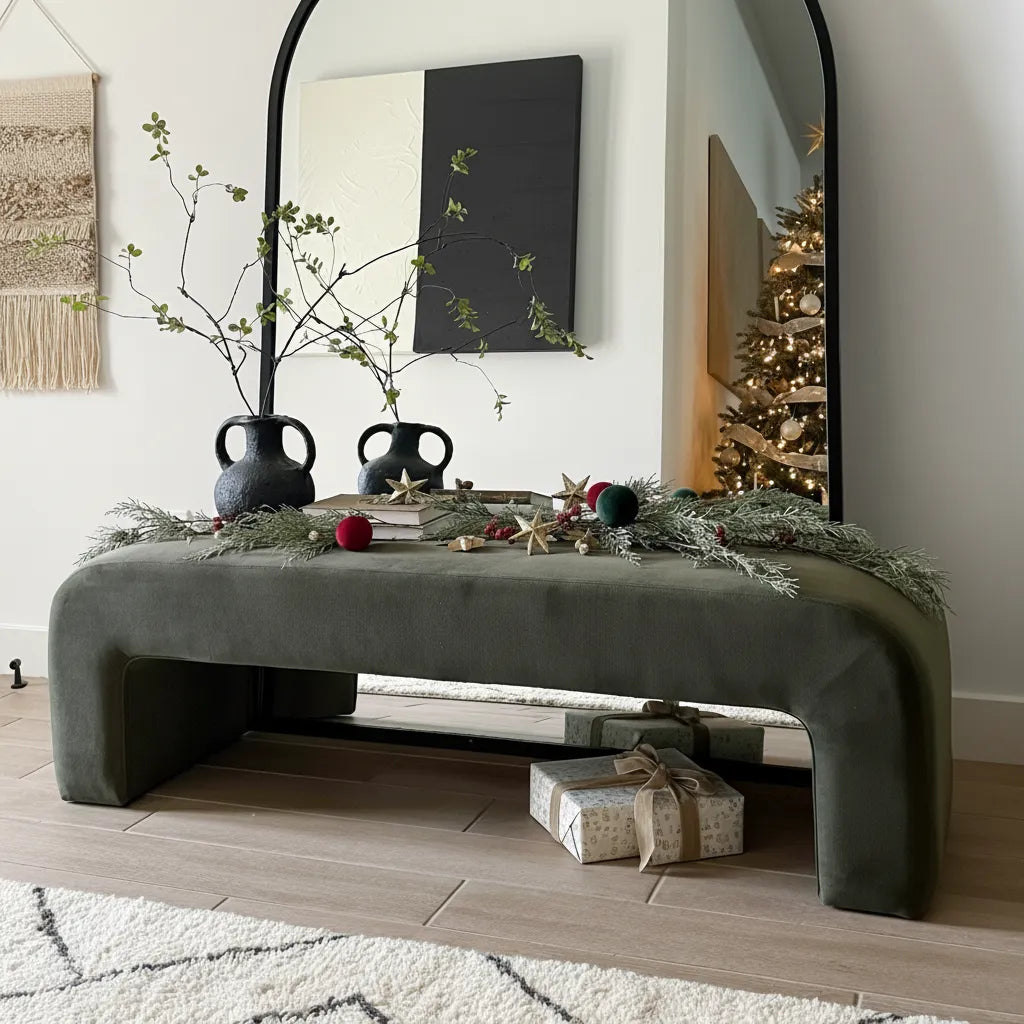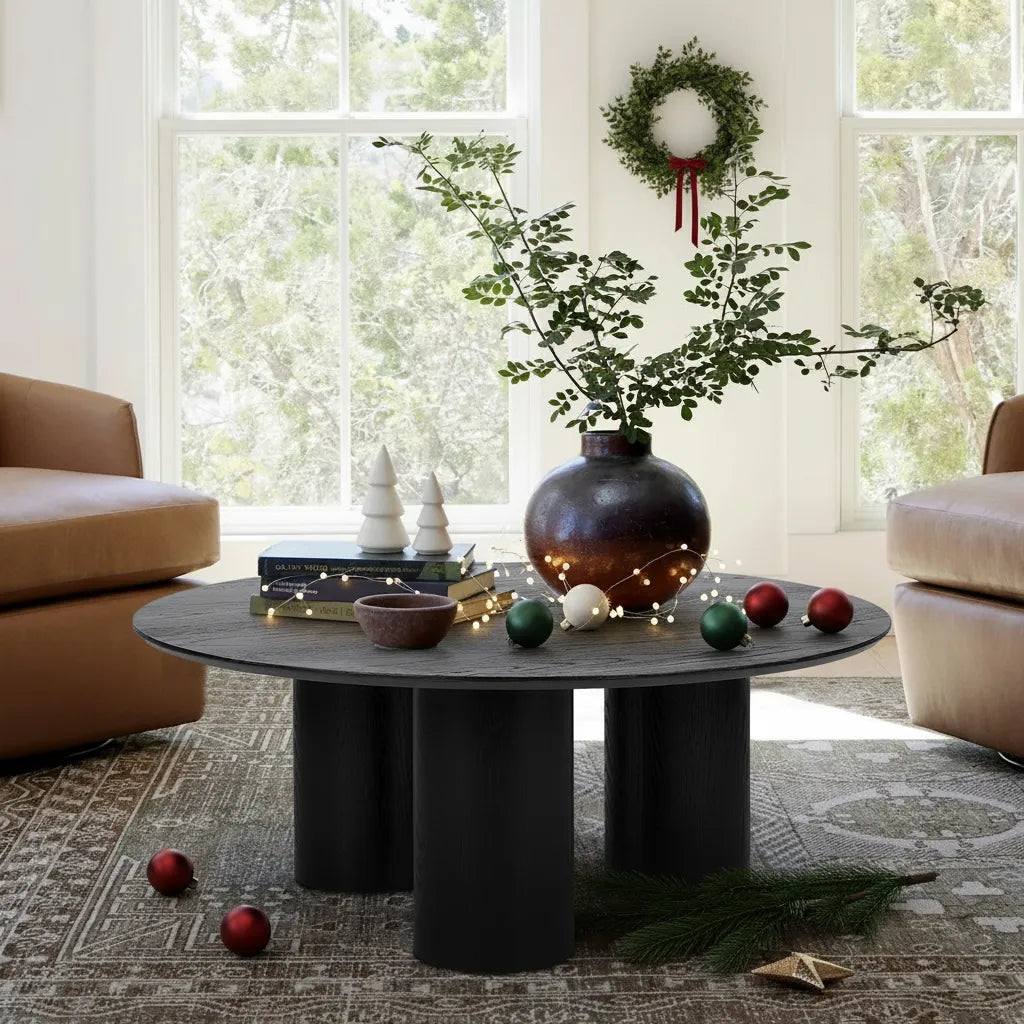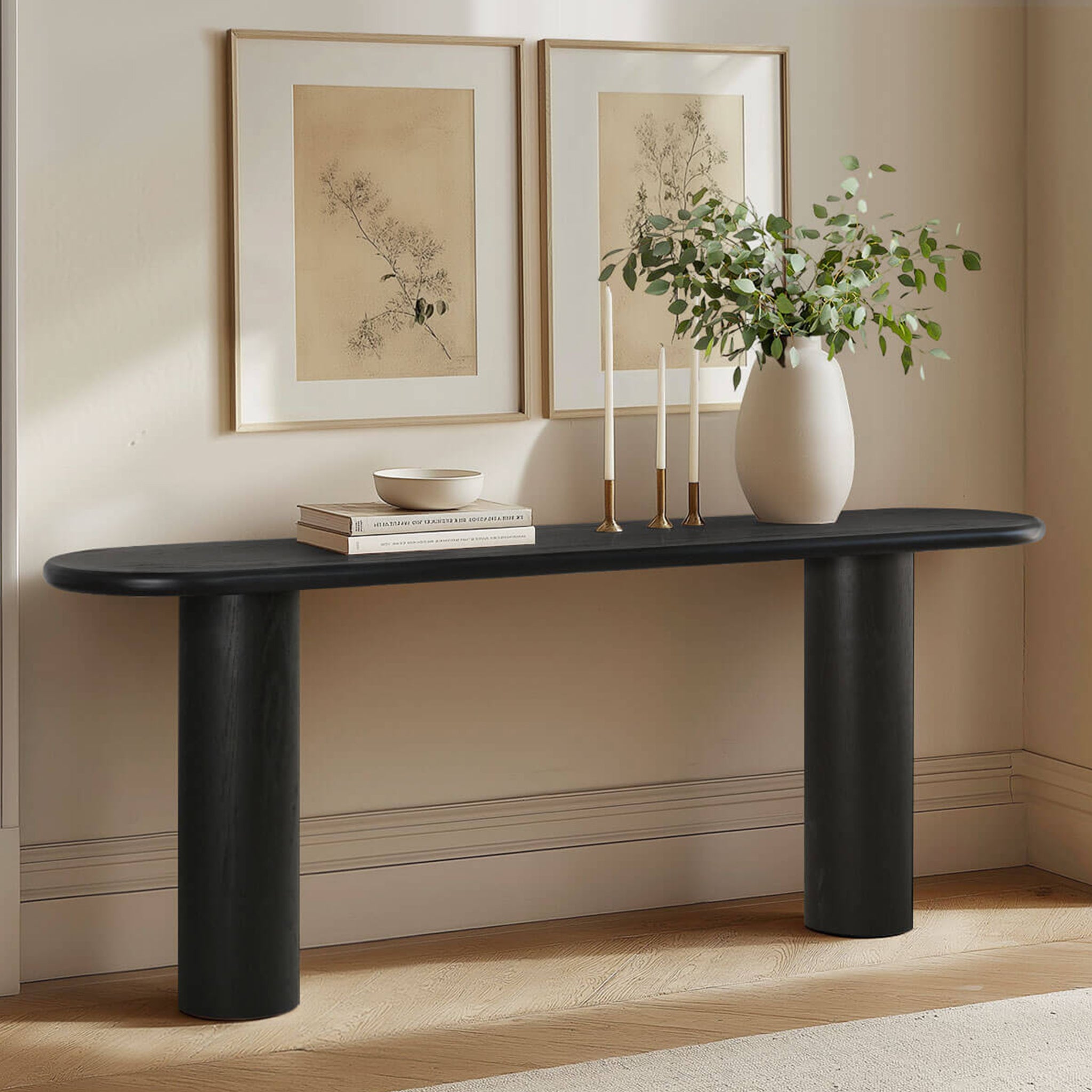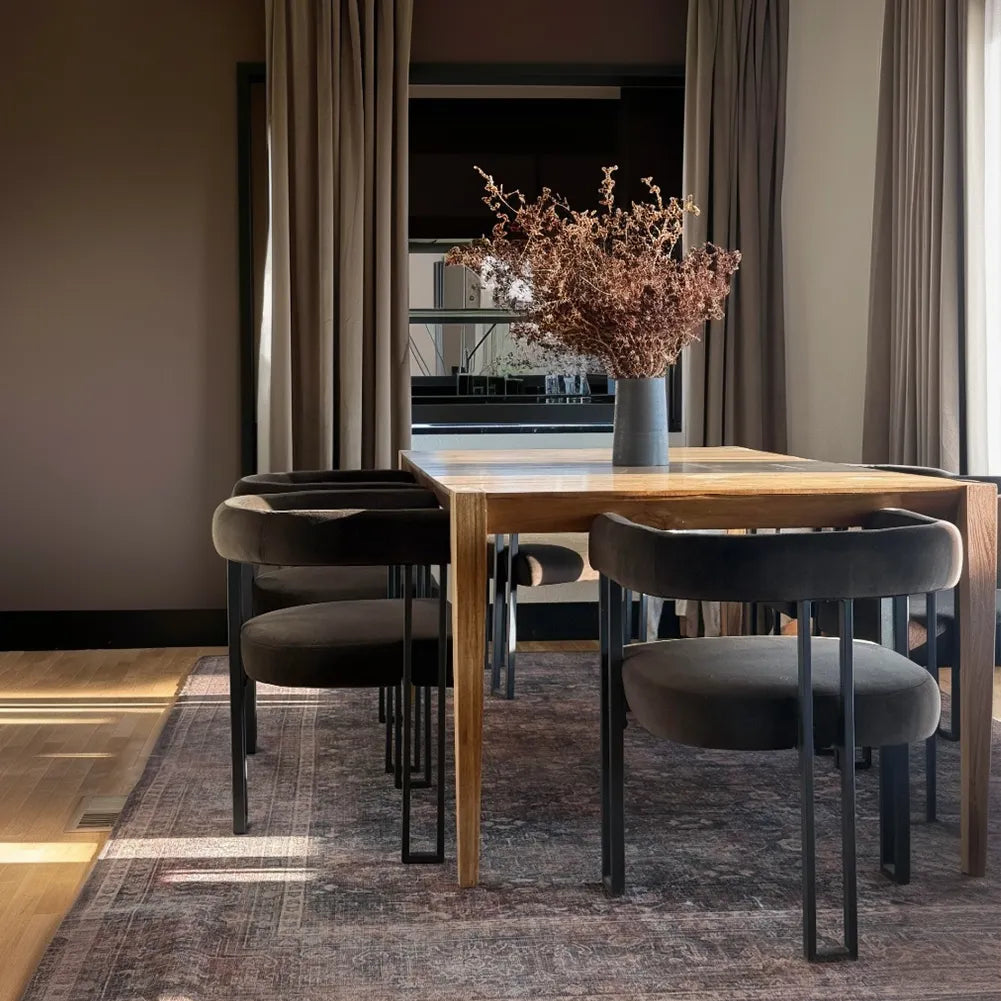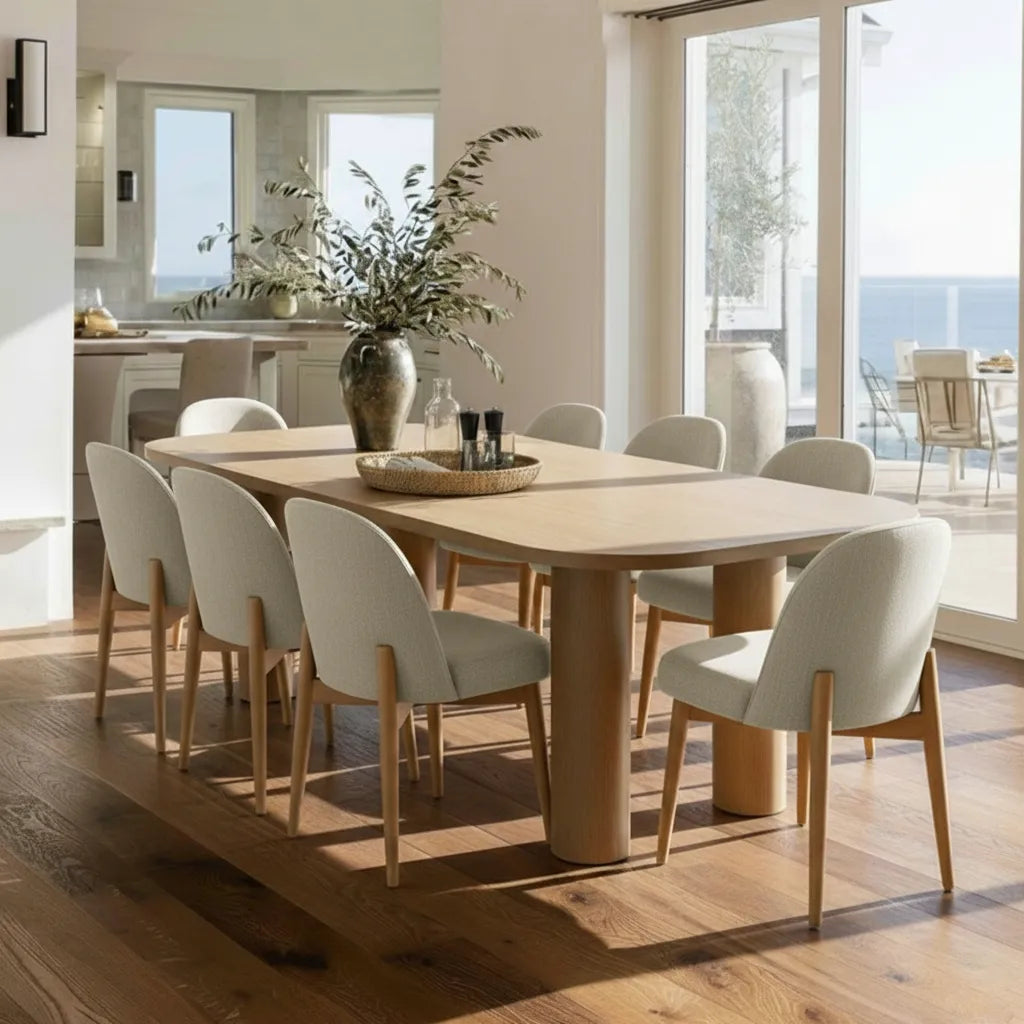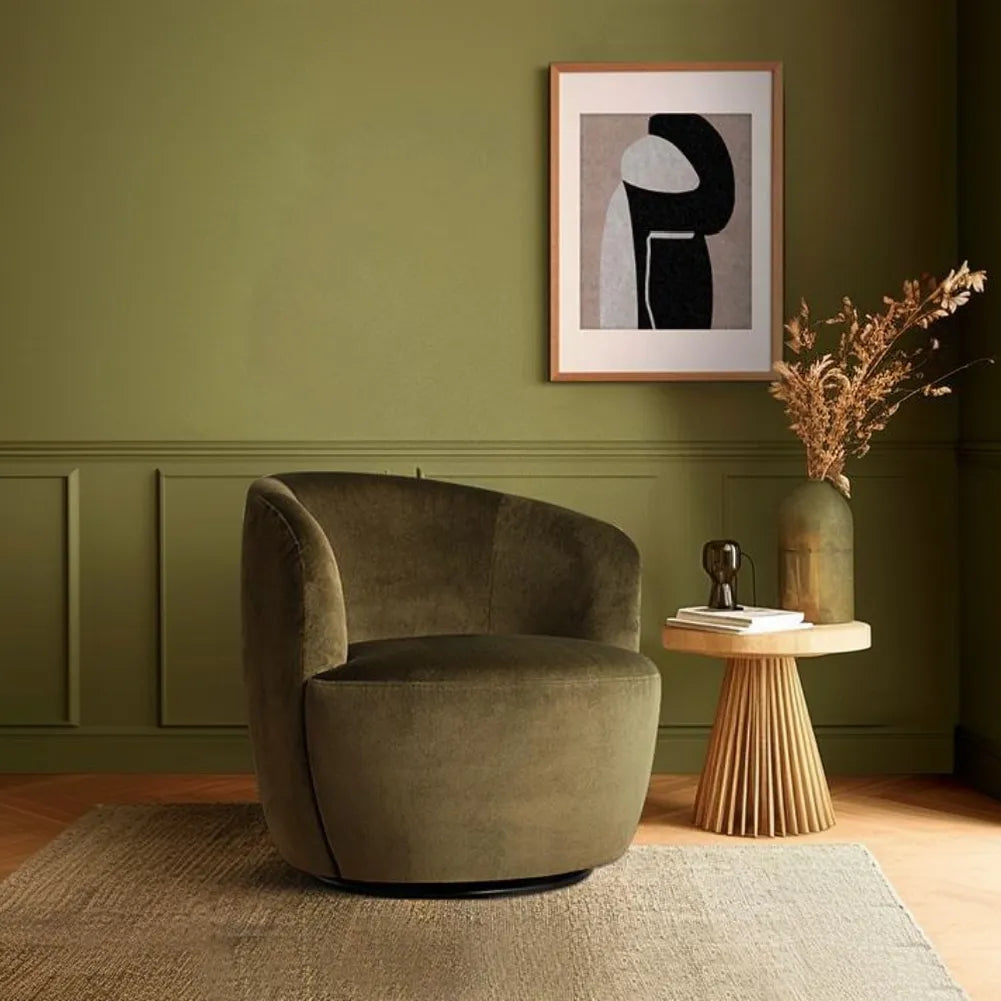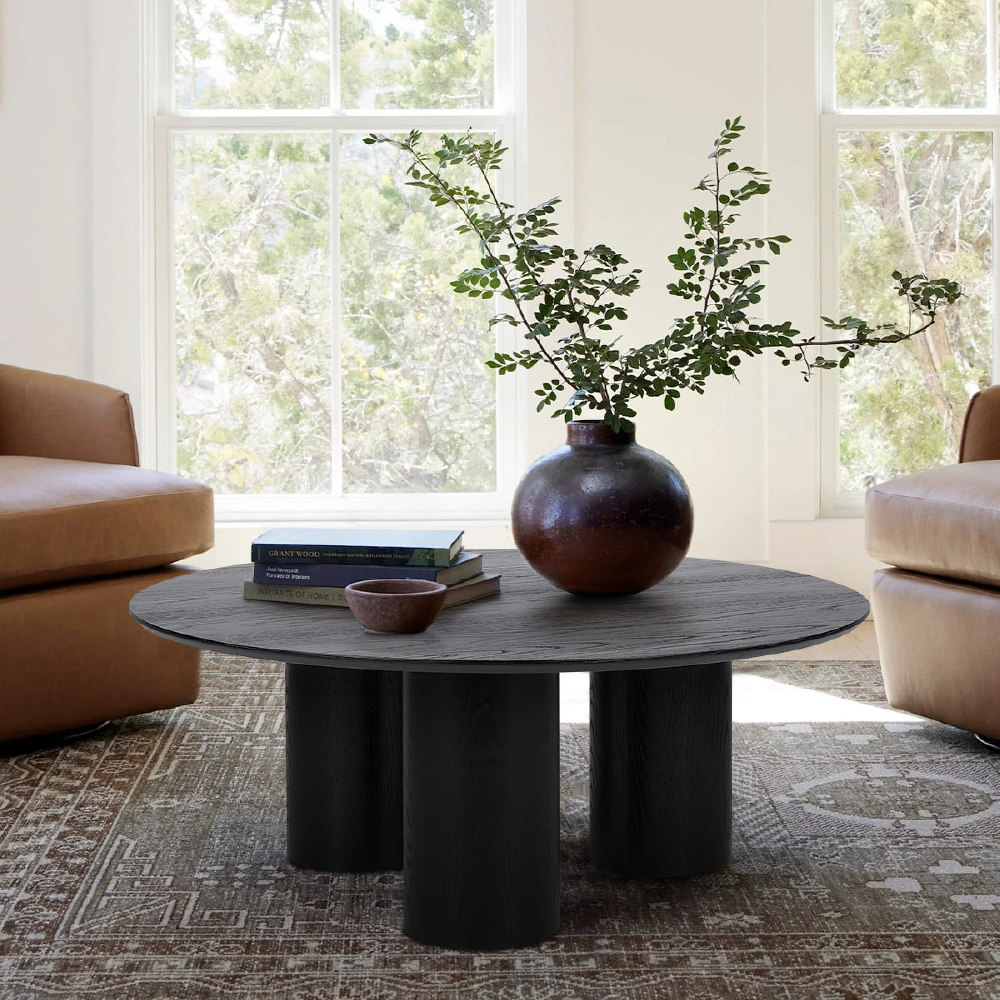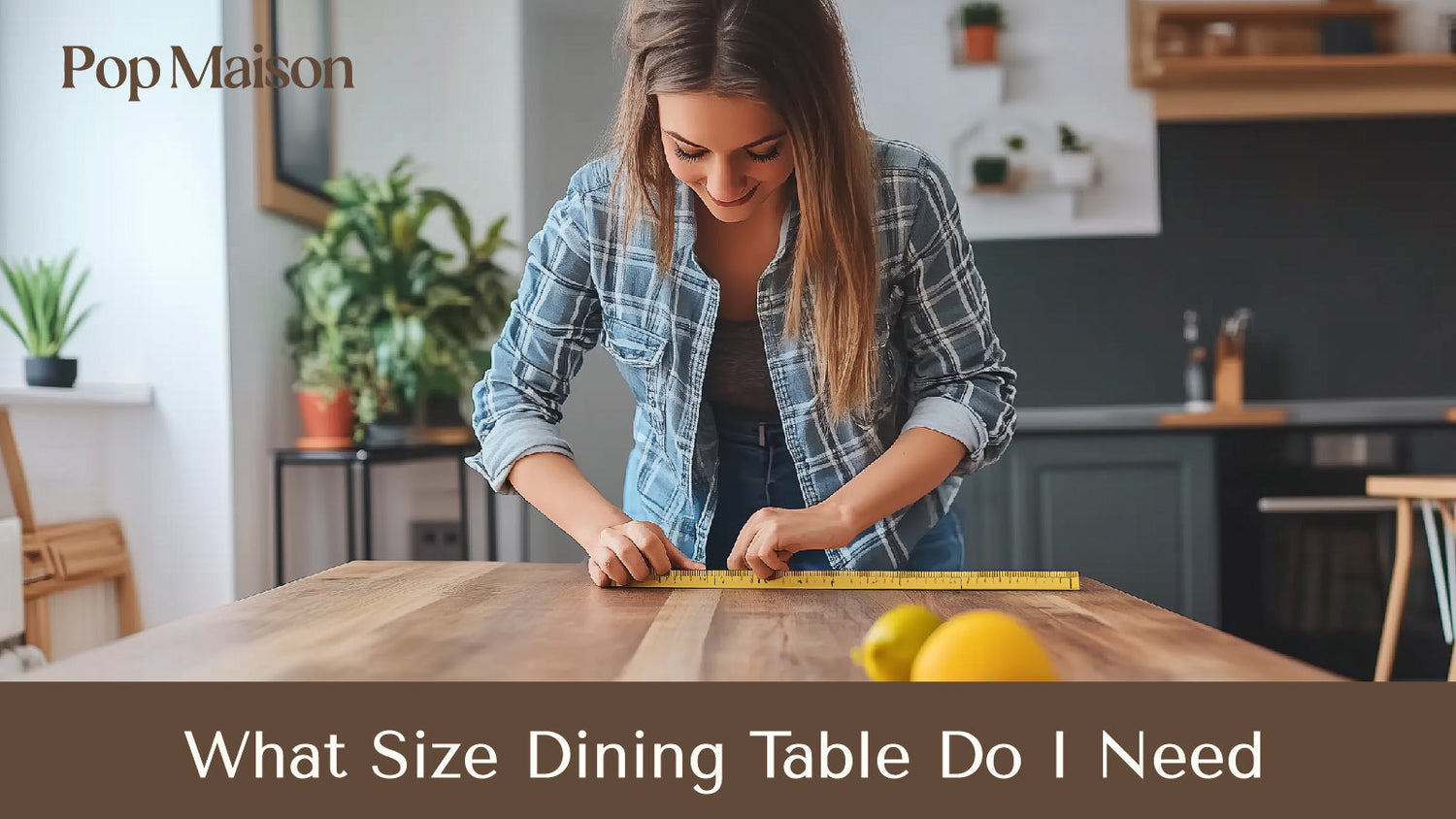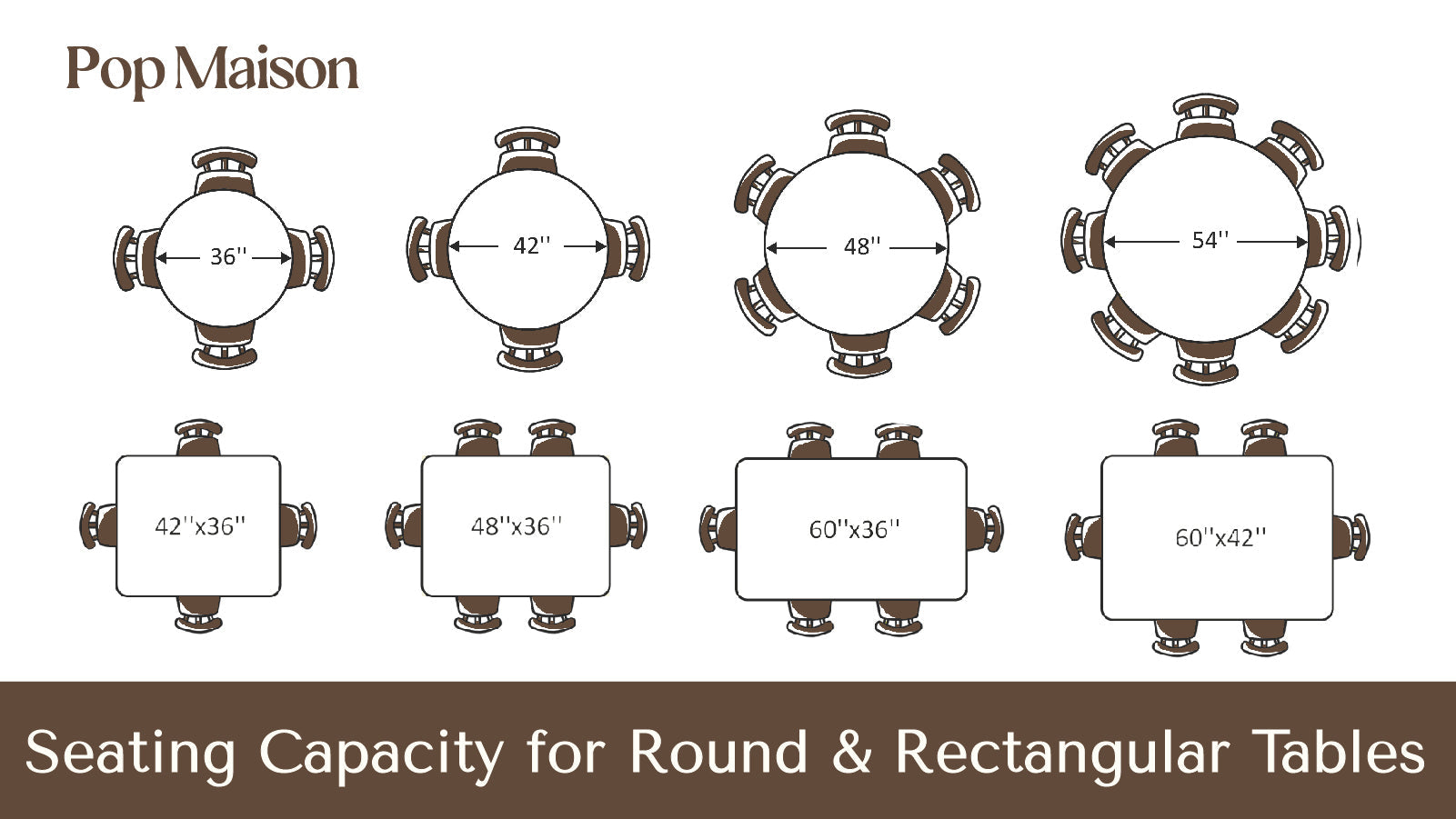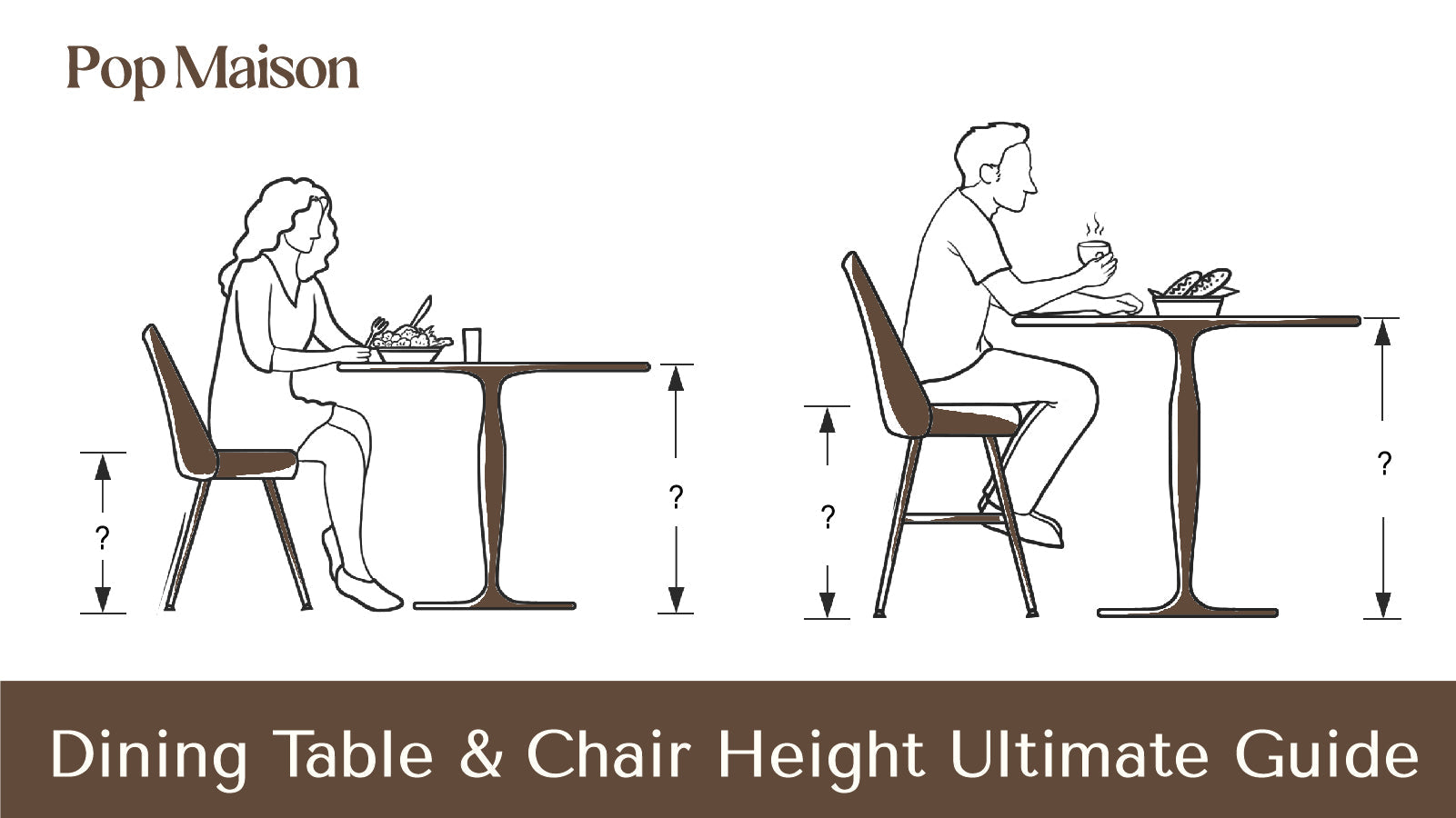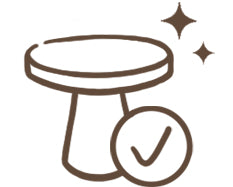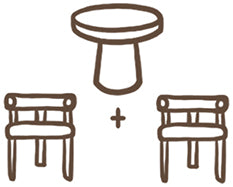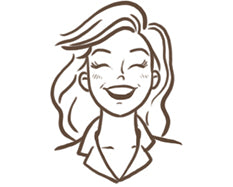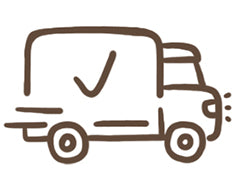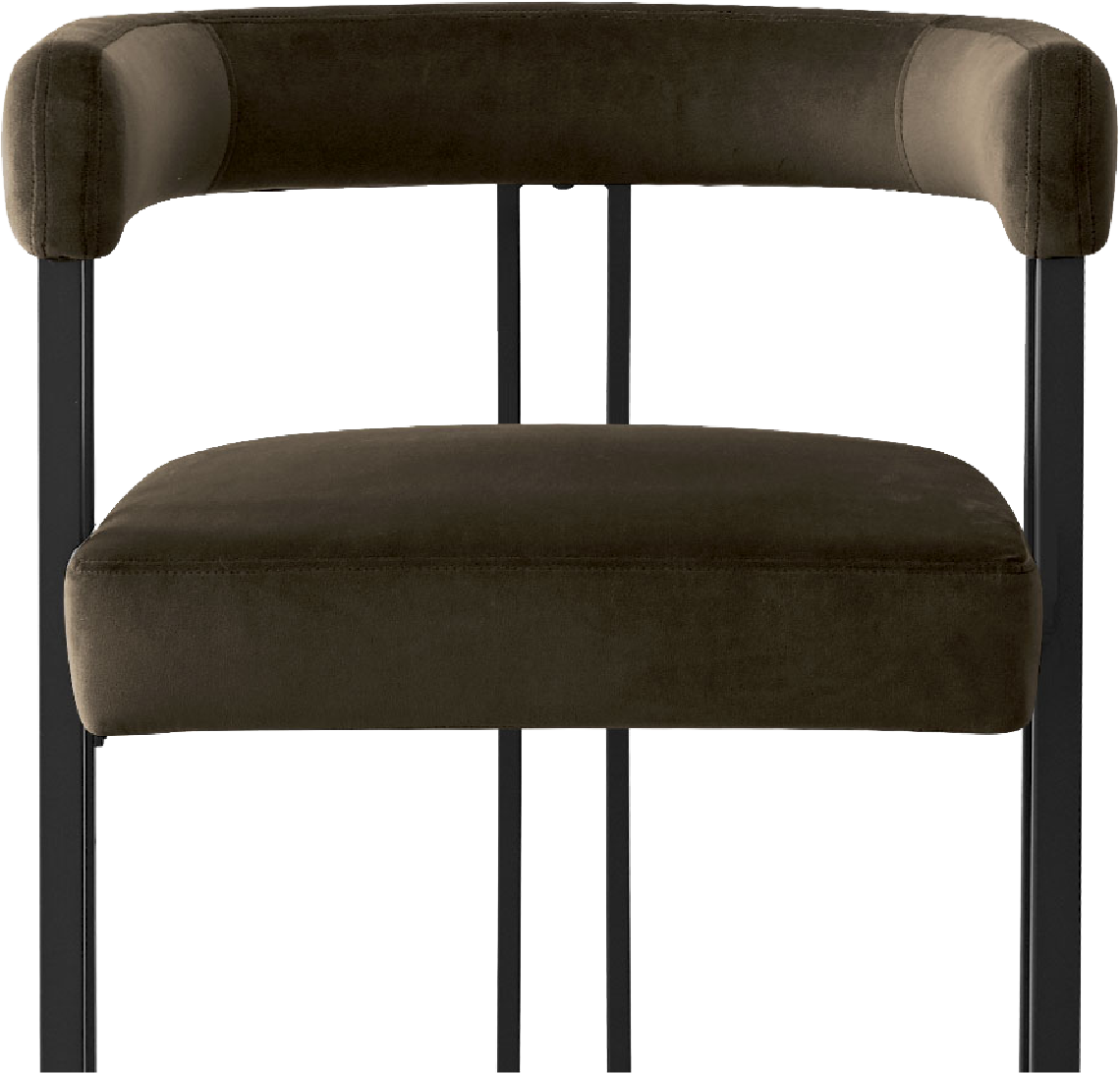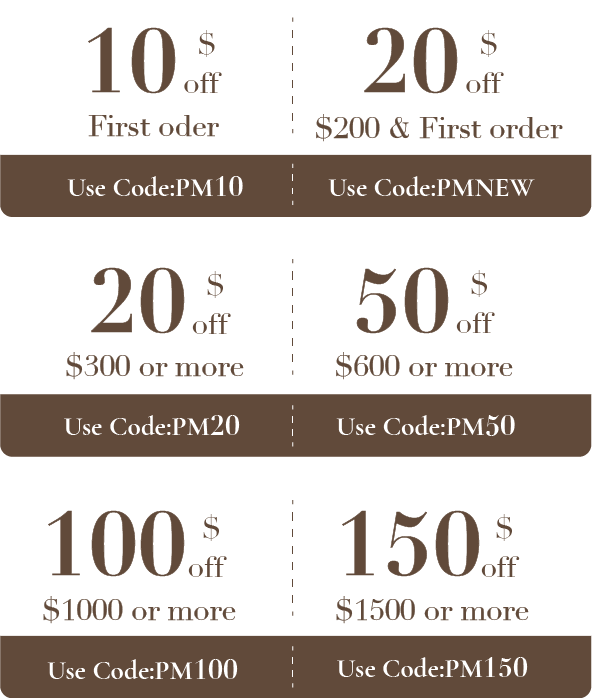The size dining table you need depends on key factors including the number of people in your household, the size of the dining room or area, and whether you use the table for purposes other than eating.
This guide to dining table size includes information about table size and seating, the right size table for each common room size and tips for calculating the right size dining table for your needs. Handy charts are included for round and rectangular dining tables to help you make an informed decision when determining the best dining table size.
Table Size and Number of Seats
Dining tables seat 4 to 12 people, typically, with tables seating for 4-8 being the most popular sizes.
The first major issue to consider is how many people you want your table to seat. Large families and households where entertaining guests is common will need a larger table able to seat more people.
Smaller households where guests are not frequent need a smaller table especially if the table is mainly for eating and doesn’t double as workspace for working from home, crafting or other activities.
How much space per person is needed at a dining room table? The recommended space is at least 24 inches per person. This is the amount of space considered by table manufacturers as they design sets – table length and number of chairs included in the set.
The 24 inches allows for between 2 inches, which can make the table feel crowded, to 8 inches, which is roomy. If your household includes children or adults of smaller stature, then less space between chairs might be sufficient. When individuals are larger, more space between chairs will be appreciated.

Round dining tables begin at a diameter of 35” to 36” across, and up to about 60” across. Some manufacturers make larger diameter dining tables, but they are not space-effective for most homes.
Note: Diameter is the distance across the table - a line going through the center of the table from side to side.
Rectangular tables start at about 42” long and range to 144” long, though the majority are 48” to 96”, or 4 to 8 feet long.
Round dining table sizes:
- Small round dining tables: 35” to 42” diameter
- Medium round dining tables: 44” to 52” diameter
- Large dining tables: 54” to 60” diameter
Rectangular dining table sizes:
- Small rectangular dining tables: 44” to 66” long
- Medium rectangular dining tables: 66” to 84” long
- Large rectangular dining tables: 84” to 108”
- Extra large rectangular dining tables: 108” to 144”
Round Dining Tables
|
Table Diameter |
Seating |
Space per Chair (1) |
|
35" to 42" |
Up to 4 |
27.5" to 33" |
|
44" to 52" |
Up to 6 |
27" to 34.5" |
|
54" to 72" |
Up to 8 |
23.5" to 32" |
|
66" to 84" |
Up to 10 |
24" to 30.5" |
- The Space per Chair column is designed to show you, given the dimensions, how close chairs will be to one another.

Rectangular Dining Tables
|
Table Length |
Table Width |
Seating |
Space per Chair |
|
42" to 44" |
36" to 42" |
Up to 4 |
21" |
|
44" to 48" |
36" to 42" |
Up to 6 |
21" to 24" |
|
54" to 66" |
36" to 42" |
Up to 6 |
27" to 33" |
|
66" to 84" |
36" to 48" |
Up to 8 |
22" to 28" |
|
72" to 84" |
42" to 48" |
Up to 10 |
24" to 28" |
|
84" to 102" |
40" to 48" |
Up to 10 |
25" to 28" |
|
102" to 144" |
40" to 48" |
Up to 12 |
25" to 36" |

How Many Chairs Fit At an Oval Table?
The same number of chairs fit at an oval table as at a rectangular table. For example, if the oval table is 66” to 84” long, then it will seat up to 8 chairs.
Dining Table Size Based on Dining Area Size
The size of your dining room or dining area is a key factor in how large your dining table can be.
At least 36 inches (3 feet) of clearance around the dining table is recommended from the table edge to the wall or other furniture. This allows diners to easily get to their seat and provides plenty of room for servers to reach each seat.
However, where space is tight, a minimum of 24” (2 feet) might be workable where chairs can be tucked under the table when not in use.
If the dining chairs have arms that cannot be tucked under the table, then a minimum of 42” between the table edge and the wall is recommended.
When the room does not have any other furniture besides dining table and chairs, the table can be larger. When the room has additional furniture, the table may have to be smaller.
Room Layout and Additional Furniture
Another consideration is whether there is other furniture in the room. Many dining rooms have a buffet or sideboard, hutch, china cabinet, serving cart and similar furniture.
The same principle applies when considering furniture as when measuring from the table to walls. Traffic flow and the comfort of diners is ensured when there is a minimum of 24” between the table and these dining room furniture, but at least 36” is ideal.
Here are common dining area sizes with the minimum and maximum table sizes for those spaces.

Round Tables
|
Dining Area w/o Furniture |
Minimum Table Size |
Maximum Table Size |
|
8x8 |
35" round |
48" round |
|
10x10 |
35" round |
52" round |
|
12x10 |
40" round |
60" round |
|
14x12 |
48" round |
78" round |
|
16x14 |
60" round |
96" round |
|
20x16 |
72" round |
120" round |
Rectangular Tables
|
Dining Area w/o Furniture |
Minimum Table Size |
Maximum Table Size |
|
8x8 |
48"x42" |
60"x48" |
|
10x10 |
48"x42" |
72"x48" |
|
12x10 |
60"x48" |
96"x48" |
|
14x12 |
84"x48" |
120"x48" |
|
16x14 |
108"x48" |
144"x48" |
|
20x16 |
120"x48" |
168"x48" |
If your dining area includes additional furniture, then your table will have to be smaller. In fact rooms 10x10 and smaller are too small to allow for both a dining table and chairs plus additional furniture such as a sideboard or buffet, hutch, or large china cabinet.
Here are common dining area sizes and the minimum and maximum table sizes you can have when the space includes extra furniture.
Round Tables
|
Dining Area with Furniture |
Minimum Table Size |
Maximum Table Size |
|
8x8 |
N/A |
N/A |
|
10x10 |
N/A |
N/A |
|
12x10 |
35" round |
48" round |
|
14x12 |
54" round |
60" round |
|
16x14 |
60" round |
72" round |
|
20x16 |
68" round |
84" round |
Rectangular Tables
|
Dining Area with Furniture |
Minimum Table Size |
Maximum Table Size |
|
8x8 |
N/A |
N/A |
|
10x10 |
N/A |
N/A |
|
12x10 |
42"x42" |
72"x42" |
|
14x12 |
60"x42" |
96"x48" |
|
16x14 |
72x42" |
108"x48" |
|
20x16 |
84"x42" |
144"x48" |
Calculating Dining Table Size Based on People Number
The dining table size in both length and width determines how many people can sit comfortably at the table with an average space of 24 inches per chair.
Note:The table should be at least 42 inches wide to have two chairs on the end. But they would need to be fairly narrow chairs. Having 48 inches on the end is better for two chairs on the end.
Here are common numbers of people at the table and the minimum table size needed to accommodate them.
Round Tables
|
People |
Table Diameter |
Diameter in Feet |
|
2-4 |
35" to 48" |
About 3' to 4' |
|
5-6 |
40" to 60" |
4.33' to 5' |
|
7-8 |
48" to 72" |
4' to 6' |
|
9-10 |
66" to 84" |
5.5' to 7' |
Rectangular Tables
|
People |
Table Sizes L x W |
Size in Feet L x W |
|
2-4 |
42"x40" to 66"x42" |
3.5'x3.3 to 5.5'x3.5' |
|
5-6 |
48"x42" to 72"x42" |
4'x3.5' to 6'x3.5' |
|
7-8 |
84"x42" to 96"x48" |
7'x3.5' to 8'x4' |
|
9-10 |
84"x48" to 120"x48" |
7'x4' to 10'x4' |
|
11-12 |
120"x48" to 144" x 48" |
10'x4' to 12'x4' |
Dining Table Function and Size
How you plan to use the table is a factor to consider when choosing the right dining table size.
When the table will be used exclusively or nearly so for eating, then the table sizes given in the charts above are a reliable guide.
However, many households use the dining table for additional purposes such as a desk for working from home or for students doing homework, a crafting table or sewing table, as a table for enjoying games and puzzles, folding laundry and other household tasks.
When the table is used for more than just eating, it is recommended that you consider buying a table with a minimum of 6 seats up to the maximum size that will fit in the room or area.
Expandable Dining Tables
An expandable dining table is a table with leaves that can be removed, that fold or drop down or are concealed. Expandable dining tables allow you to adjust your table size for dinner and for additional purposes.
Depending on design, expandable tables are also called extendable tables, extension tables, drop-leaf tables, butterfly tables or simply tables with leaves. They provide versatility of use, giving you the opportunity to create the right size surface for the number of seats needed for a meal or for another purpose.
This chart shows dining tables that seat 4, 6 and 8 with no leaves and how many the table can accommodate when 1, 2, 3 or 4 leaves are added.
|
No Leaves |
1 Leaf |
2 Leaves |
3 Leaves |
4 Leaves |
|
4 |
6 |
6-8 |
8-10 |
12-14 |
|
6 |
8 |
8-10 |
10-12 |
14-16 |
|
8 |
10 |
10-12 |
12-14 |
16-18 |
Make a Physical Mock-up
A mock-up of a dining table is a faux tabletop made from cardboard taped or glued together. Thin plywood, poster board or similar lightweight material that is easy to cut can be used.
Lay the pieces of cardboard or other material on the floor. Tape pieces together until you create a tabletop of the largest size you are considering. Some cutting and trimming with scissors or a utility knife might be necessary.
Tape the edges quite heavily to prevent the fake tabletop from coming apart. It might help to set the mock-up on a small table, but leaving it on the floor at least allows you to see how a table that size would fit in the space.
Measure from the edges of the faux top to the walls or large pieces of furniture you intend to leave in the space. Make sure that you have a minimum of 24” to the walls or furniture, although 36” clearance from the table to walls or furniture is preferred.
If the mock-up is too large, cut down its length and/or its width to the next smallest size you’re considering. Continue to cut down the mock-up dining table until you get the “perfect” fit for your space.
Dining Table Height
The height of dining tables ranges from 28 inches to 42 inches.
The height of standard dining tables is 28”-30”. The height of counter-height dining tables is 34”-36”. And the height of bar-height dining tables is 40”-42”.
Considering height allows you to determine the best overall dining table dimensions for your dining room or area.
Avoid Common Mistakes
Being aware of common buying mistakes allows you to avoid them and purchase a table you will be happy with for many years to come.
Overestimating room size is the first common mistake. Don’t just estimate room size. Measure the room. Use a tape measure to determine the exact length and width of the room. It is a common surprise to find out that the room is not as big as expected.
Secondly, failing to measure the room with furniture in it is a mistake. Measure the floor area not covered by furniture. This is the true amount of space you have to work with when deciding on the right dining room table size.
The result of overestimating the size of the room or area is buying a table that is too big for the space. This creates difficulty in getting around chairs when people are sitting in them.
Another common mistake is to buy a table that is too small for the room or your needs. In terms of the room, for example, a 60”x40” table, 5’x3.33’, may look undersized in a dining room that is 15x12 or larger. Even if you don’t need the seating, it would be better to choose a dining table at least 7 feet long and 3.5 or 4 feet wide in a space that large.
*Keep in mind that most standard dining tables are 38” to 48” wide, and those widths are considered in the chart above. But you can find a small selection of tables that are wider than 48”, but they typically must be custom ordered.
In terms of your seating needs, consider the growth of your family or household. Growing kids will need more room as they grow. And if you have more children or add members to your household, you will want additional seating. Also consider how often you entertain and whether you typically invite just a few guests or a larger number.
Failing to consider an expandable dining table is a mistake. Tables with leaves give you versatility in how large the table is and how it can be used.
The final mistake is not considering other ways you will use the table – work, homework, games, crafts, folding laundry, etc. If the dining area is large enough to accommodate it, you’ll probably be happy with a big table to meet your dining needs and to be used for a range of other purposes.
How to Choose the Right Table Size
These rules provide guidance for choosing the right dining table size.
Remember the rule of clearance. It says that at least 36” (3 feet) between the table and all walls or furniture is preferred. A bare minimum amount of space is 24” (2 feet). This rule is true for both round and rectangular dining tables.
Seating space per person is at least 24” for optimal comfort. You can get by with as little as 21” per person with narrow chairs, but large individuals will find this amount of space quite tight.
Consider an extendable table. As noted, a dining table with leaves gives you the freedom to remove the leaves for a small party of diners and to add the leaves for larger groups or for using the table for purposes other than eating.
Keep in mind the typical number of people who sit at the table at most meals. Then determine the minimum table size you need for that number. For example, for 4 people, the minimum table size is 42”x40”. For 6 people, the minimum rectangular table size is 48”x42” with two people on each of the long sides and one on each end. The minimum round table size for 6 people is 46” for comfortable seating.
Consider how often you have friends for dinner or use the table for other purposes. If you entertain a lot, or if the table doubles as a desk, craft table or other purpose, consider a larger table. You’ll be glad that you did.

